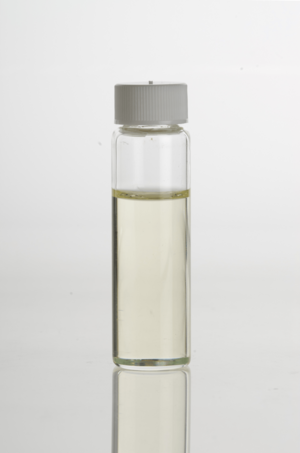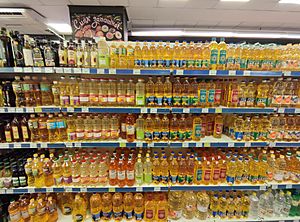Sunflower oil facts for kids
Sunflower oil is a type of oil that comes from pressing the seeds of the sunflower plant (Helianthus annuus). It's a very popular oil used in many ways.
You'll often find sunflower oil in food, especially for frying. It's also used in cosmetics like lotions and creams because it helps make skin soft.
Sunflower oil is mostly made of two main types of fats: linoleic acid (a polyunsaturated fat) and oleic acid (a monounsaturated fat). Scientists and farmers use special breeding methods to create different kinds of sunflower oils. These oils have different amounts of these fats. The oil usually has a mild taste. It also contains a good amount of vitamin E, which is important for your body.
In 2018, Ukraine and Russia produced more than half of the world's sunflower oil. Scientists are still working on improving sunflower plants to produce even more oil to meet the world's needs.
Contents
What is Sunflower Oil Made Of?
Sunflower oil is mainly a type of fat called a triglyceride. These fats are made up of smaller parts called fatty acids. Different types of sunflower oil have different amounts of these fatty acids:
- Palmitic acid: About 5% (a saturated fat)
- Stearic acid: About 6% (a saturated fat)
- Oleic acid: About 30% (a monounsaturated fat, also known as omega-9)
- Linoleic acid: About 59% (a polyunsaturated fat, also known as omega-6)
Farmers and scientists have developed four main types of sunflower oils. They do this by breeding sunflowers to produce seeds with different amounts of these fatty acids:
- High-linoleic oil: This type has about 69% linoleic acid.
- High-oleic oil: This type has about 82% oleic acid.
- Mid-oleic oil: This type has about 65% oleic acid.
- High-stearic with high-oleic oil: This special type has about 18% stearic acid and 72% oleic acid.
| Sunflower oil production – 2019 | |
|---|---|
| Country | (millions of tonnes) |
| 5.84 | |
| 5.42 | |
| 1.41 | |
| 1.10 | |
| 0.69 | |
| 0.53 | |
| 0.53 | |
| 0.52 | |
| 0.49 | |
| 0.32 | |
| World | 20.29 |
| Source: FAOSTAT of the United Nations | |
Scientists study the sunflower's genome (its complete set of DNA) to learn more about how the plant makes its oil. They have found other useful compounds in sunflower oil, like phytosterols, polyphenols, and squalene.
How Sunflower Oil is Made
In 2018, the world produced about 18 million tonnes of sunflower oil. Ukraine and Russia were the biggest producers, making more than half of it together.
In 2022, there was a big shortage of sunflower oil around the world. This was because of events in Ukraine and Russia, which caused the amount of sunflower oil available to drop by more than 50%. Because of this shortage, many food companies had to change their recipes. They started using other oils, like rapeseed oil, to keep making their products.
Extracting the Oil
Sunflower oil can be taken out of the seeds in a few ways:
- Chemical solvents: One way is using chemicals, like hexane, to dissolve the oil from the seeds.
- Expeller pressing: Another way is to squeeze the oil directly from the sunflower seeds. This is like crushing them to get the oil out.
- Cold-pressing: This is a type of expeller pressing done at low temperatures. It doesn't use any chemical solvents.
Refined vs. Unrefined Oil
Sunflower oil can be either refined or unrefined.
- Refined sunflower oil: This oil goes through several cleaning steps, including using solvents, removing gums, and bleaching. This process makes the oil more stable. It's better for cooking at high temperatures. However, refining removes some of the oil's nutrients, flavor, and color. It also changes some healthy fats into trans fats due to the heat. Refined oil is usually pale yellow.
- Unrefined sunflower oil: This oil is not processed as much. It's less stable and not as good for high-temperature cooking. But it keeps more of its natural nutrients, flavor, and light-amber color. It's great for raw dishes or cooking at lower temperatures.
Uses of Sunflower Oil
In Food
Refined sunflower oil is used for all kinds of cooking, from low to very high temperatures. It works well as a frying oil. Unrefined sunflower oil is often used as a traditional salad dressing in Eastern European cuisines. Sunflower oil is also an ingredient in sunflower butter, a spread similar to peanut butter.
Many snack foods, like potato chips and French fries, are cooked using sunflower oil.
Seed Meal
After the oil is taken out of sunflower seeds, what's left is called "seed meal." This meal is full of protein and fiber. It's often used as food for animals, as a fertilizer for plants, or even as a fuel.
In Cosmetics
Sunflower oil is also used in the cosmetics industry. For example, a substance called PEG-10 sunflower glycerides, which comes from sunflower oil, is used in many cosmetic products.
In Gardening
In some places, like the European Union and the United Kingdom, sunflower oil is sprayed on tomato plants. It acts as a fungicide to help control a plant disease called powdery mildew. It's considered a 'Basic Substance' and can be used on both organic and regular farms.
Nutrition and Properties
| Nutritional value per 100 g (3.5 oz) | |
|---|---|
| Energy | 3,699 kJ (884 kcal) |
|
0 g
|
|
|
100 g
|
|
| Saturated | 9.748 g |
| Monounsaturated | 83.594 g |
| Polyunsaturated | 3.798 g |
|
Protein
|
0 g
|
| Vitamins | Quantity
%DV†
|
| Vitamin E |
274%
41.08 mg |
| Vitamin K |
5%
5.4 μg |
| †Percentages estimated using US recommendations for adults. | |
| Nutritional value per 100 g (3.5 oz) | |
|---|---|
| Energy | 3,699 kJ (884 kcal) |
|
0 g
|
|
|
100 g
|
|
| Saturated | 10.3 g |
| Monounsaturated | 19.5 g |
| Polyunsaturated | 65.7 g |
|
Protein
|
0 g
|
| Vitamins | Quantity
%DV†
|
| Vitamin E |
274%
41.08 mg |
| Vitamin K |
5%
5.4 μg |
| †Percentages estimated using US recommendations for adults. | |
| Nutritional value per 100 g (3.5 oz) | |
|---|---|
| Energy | 3,699 kJ (884 kcal) |
|
0 g
|
|
|
100 g
|
|
| Saturated | 9.009 g |
| Monounsaturated | 57.344 g |
| Polyunsaturated | 28.962 g |
|
Protein
|
0 g
|
| Vitamins | Quantity
%DV†
|
| Vitamin E |
274%
41.08 mg |
| Vitamin K |
5%
5.4 μg |
| †Percentages estimated using US recommendations for adults. | |
Sunflower oil is a great source of vitamin E. This vitamin is an antioxidant that helps protect your body's cells. As you can see in the tables, different types of sunflower oil have different amounts of fats, but they all provide vitamin E.
Sunflower oil is liquid at room temperature. When it's refined, it's clear and a bit amber-colored, with a mild, fatty smell.
| Smoke point (refined) | 232 °C | 450 °F |
| Smoke point (unrefined) | 107 °C | 225 °F |
| Density (25 °C) | 918.8 kg/m3 | |
| Refractive index (25 °C) | ≈1.4735 | |
| Saponification value | 188-194 | |
| Iodine value | 120-145 | |
| Unsaponifiable matter | 1.5-2.0% | |
| Viscosity (25 °C), unrefined | 0.04914
kg/(m*s) |
Storing Sunflower Oil
Sunflower oil can go bad if it's exposed to heat, air, or light. These things can cause it to oxidize, which means it reacts with oxygen and spoils. To keep sunflower oil fresh and full of nutrients, it's best to:
- Store it in a cool place.
- Keep it in dark-colored glass bottles or plastic bottles that block ultraviolet light.
Properties of vegetable oils
| The nutritional values are expressed as percent (%) by mass of total fat. | |||||||||
| Type | Processing treatment |
Saturated fatty acids |
Monounsaturated fatty acids |
Polyunsaturated fatty acids |
Smoke point | ||||
|---|---|---|---|---|---|---|---|---|---|
| Total | Oleic acid (ω-9) |
Total | α-Linolenic acid (ω-3) |
Linoleic acid (ω-6) |
ω-6:3 ratio |
||||
| Avocado | 11.6 | 70.6 | 52–66 | 13.5 | 1 | 12.5 | 12.5:1 | 250 °C (482 °F) | |
| Brazil nut | 24.8 | 32.7 | 31.3 | 42.0 | 0.1 | 41.9 | 419:1 | 208 °C (406 °F) | |
| Canola | 7.4 | 63.3 | 61.8 | 28.1 | 9.1 | 18.6 | 2:1 | 238 °C (460 °F) | |
| Coconut | 82.5 | 6.3 | 6 | 1.7 | 175 °C (347 °F) | ||||
| Corn | 12.9 | 27.6 | 27.3 | 54.7 | 1 | 58 | 58:1 | 232 °C (450 °F) | |
| Cottonseed | 25.9 | 17.8 | 19 | 51.9 | 1 | 54 | 54:1 | 216 °C (420 °F) | |
| Flaxseed/linseed | 9.0 | 18.4 | 18 | 67.8 | 53 | 13 | 0.2:1 | 107 °C (225 °F) | |
| Grape seed | 10.5 | 14.3 | 14.3 | 74.7 | – | 74.7 | very high | 216 °C (421 °F) | |
| Hemp seed | 7.0 | 9.0 | 9.0 | 82.0 | 22.0 | 54.0 | 2.5:1 | 166 °C (330 °F) | |
| Olive | 13.8 | 73.0 | 71.3 | 10.5 | 0.7 | 9.8 | 14:1 | 193 °C (380 °F) | |
| Palm | 49.3 | 37.0 | 40 | 9.3 | 0.2 | 9.1 | 45.5:1 | 235 °C (455 °F) | |
| Peanut | 16.2 | 57.1 | 55.4 | 19.9 | 0.318 | 19.6 | 61.6:1 | 232 °C (450 °F) | |
| Rice bran oil | 25 | 38.4 | 38.4 | 36.6 | 2.2 | 34.4 | 15.6 | 232 °C (450 °F) | |
| High-oleic safflower oil | 7.5 | 75.2 | 75.2 | 12.8 | 0 | 12.8 | very high | 212 °C (414 °F) | |
| Sesame | 14.2 | 39.7 | 39.3 | 41.7 | 0.3 | 41.3 | 138:1 | ||
| Soybean | partially hydrogenated | 14.9 | 43.0 | 42.5 | 37.6 | 2.6 | 34.9 | 13.4:1 | |
| Soybean | 15.6 | 22.8 | 22.6 | 57.7 | 7 | 51 | 7.3:1 | 238 °C (460 °F) | |
| Walnut oil | unrefined | 9.1 | 22.8 | 22.2 | 63.3 | 10.4 | 52.9 | 5:1 | 160 °C (320 °F) |
| Sunflower | 8.99 | 63.4 | 62.9 | 20.7 | 0.16 | 20.5 | 128:1 | 227 °C (440 °F) | |
| Cottonseed | hydrogenated | 93.6 | 1.5 | 0.6 | 0.2 | 0.3 | 1.5:1 | ||
| Palm | hydrogenated | 88.2 | 5.7 | 0 | |||||
See also
 In Spanish: Aceite de girasol para niños
In Spanish: Aceite de girasol para niños





